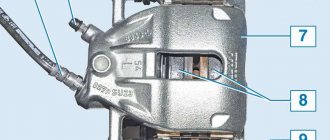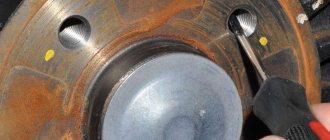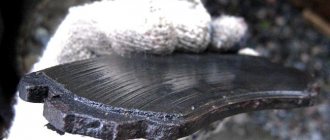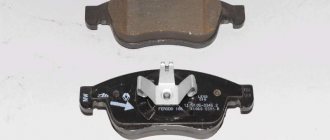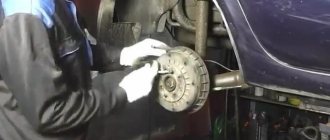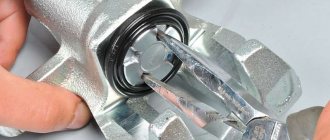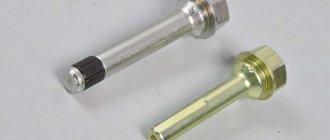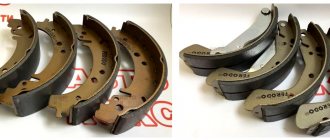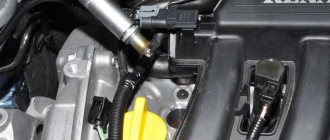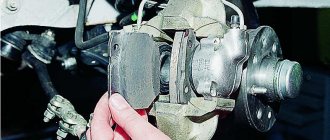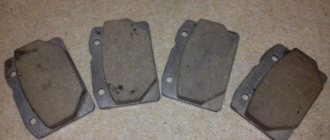We replace the pads of a Lada Largus car in case of maximum permissible wear of their linings - the minimum thickness of the pad, including its base, must be at least 6 mm. The pads also need to be replaced when the brake disc is replaced, the linings are oily or have deep grooves, cracks and chips on them, as well as when the linings detach from the base of the pads.
We carry out the work on a flat area, inspection ditch or overpass.
Attention! The brake pads of the front wheels must be replaced only as a set - all four pads. Replacing the pads of only one brake mechanism can lead to the car pulling to the side when braking.
If the fluid level in the hydraulic brake reservoir is at the MAX mark, then before installing new pads, use a syringe or rubber bulb to pump out some of the fluid from the reservoir. This operation must be performed so that when the piston is pressed into the wheel cylinder of the brake mechanism while installing new pads, fluid does not flow out from under the reservoir cap.
We remove the front wheel and securely fix the car on a factory-made support stand. Before installing new pads, it is necessary to move the wheel cylinder piston as much as possible inside the cylinder.
2283-14-02-01 (Copy)
To do this, insert a screwdriver with a wide blade through the hole in the caliper between the brake disc and the caliper and rest it on the caliper, move the bracket, recessing the piston into the cylinder.
To do this, insert a screwdriver with a wide blade through the hole in the caliper between the brake disc and the caliper and rest it on the caliper, move the bracket, recessing the piston into the cylinder.
To do this, insert a screwdriver with a wide blade through the hole in the caliper between the brake disc and the caliper and rest it on the caliper, move the bracket, recessing the piston into the cylinder.
Let's sum it up
Since the LADA Largus brake system has a significant impact on the safety of movement, the elements require increased attention and timely replacement of the front brake pads. We do not recommend allowing excessive levels of wear on the working surfaces. The specified consumable components that have become unusable should be promptly replaced. Buy products only of decent quality, which will allow you to gain confidence in the stable functioning of the brake unit only in normal mode, but also in emergency situations.
2283-14-02-02 (Copy)
Using a 13mm spanner, unscrew the bolt securing the bracket to the lower guide pin, holding the pin with a 15mm spanner.
Using a 13mm spanner, unscrew the bolt securing the bracket to the lower guide pin, holding the pin with a 15mm spanner.
Using a 13mm spanner, unscrew the bolt securing the bracket to the lower guide pin, holding the pin with a 15mm spanner.
Original or non-original?
There is an opinion that original brake pads are more effective, and their service life is much longer than non-original ones. In addition, original brake pads are made without the use of asbestos, which is hazardous to the environment. Why do many people choose non-original brake pads? The main reason is the low price for acceptable quality. And in some cases, for a low price you can find non-original brake pads that are not inferior in quality to the original.
So which Lada Largus front pads should you buy? To answer this question, we invite you to provide feedback on your pads and take part in our survey. Let us remind you that in another survey we choose the best spark plugs.
Key words: Lada Largus brakes
Found an error? Select it and press Ctrl+Enter..
Information
Visitors in the Guests
, cannot be posted on this publication.
2283-14-02-05 (Copy)
Remove the two spring clamps of the pads.
Remove the two spring clamps of the pads.
Remove the two spring clamps of the pads.
Using a metal brush, we clean the spring brackets and pad seats in their guide from dirt and corrosion.
Before installing new pads, we check the condition of the protective covers of the guide pins. We replace the torn or lost elasticity cover.
How to choose the right brake system for LADA Largus
Any conscious owner of LADA Largus, who wants to drive without risk to life and with maximum comfort for himself and his passengers, will take seriously the purchase of spare parts for the brake system.
Their functionality and durability directly determine whether the driver will be able to control the movement of the car, park normally and not get into an accident due to problems with braking. The following signs indicate that something is wrong with the brakes and one or another part needs to be replaced:
- extraneous sounds: creaks, squeals and loud noise;
- increasing the duration of the process of stopping the machine;
- untimely operation of the system (wear of the pads or other elements is indicated by both too slow and too fast a reaction).
You should not hesitate to replace individual elements or the entire system, otherwise there is a risk of sudden brake failure while driving. It may also be necessary to change the system as part of a comprehensive tuning, when the driving parameters of the Lada Largus need to be improved.
Selecting brake discs
Most often, motorists need to replace discs that wear out due to frequent or intensive use or due to excessive loading of the car.
Regardless of the cause of the failure, it is important to restore the system to functionality as soon as possible, and for this you need to find disks with optimal characteristics. Let's see what models for LADA Largus are currently on the market:
Let's see what models for LADA Largus are currently on the market:
- perforated - ideal for connoisseurs of fast driving, they are characterized by fast response, but are somewhat more expensive than usual (but they last longer!);
- ordinary ones - they attract with an affordable price, but are not suitable for variations with powerful motors. They tend to quickly overheat and reduce the effectiveness of the brakes;
- with ventilation is a good option, but such wheels are not suitable for all models in this series (you can check by studying the registration certificate of the car).
Additional items
Considering the importance of the function of the braking system, the selection of each of its parts must be taken very carefully. In particular, no cylinder will function properly if its hose is leaking.
In addition, high-quality pads are a must.
To make your car safe and well-driving, it is better to use original spare parts - they can be easily purchased online, for example, in a specialized store https://www.auto-tech.ru/. Among the things you will definitely need to buy, it is worth noting the parking brake cable, brake reservoir and brake booster, hoses and tubes, as well as repair kits for ABS calipers. Select a specific variation depending on the modification of the car and taking into account the manufacturer’s recommendations.
2283-14-02-06 (Copy)
To do this, remove the guide pin from the hole in the guide block and replace the cover.
To do this, remove the guide pin from the hole in the guide block and replace the cover.
To do this, remove the guide pin from the hole in the guide block and replace the cover.
To replace the upper guide pin cover, you need to unscrew the bolt securing the bracket to the pin and remove the bracket from the pad guide.
Before installing the pin, put a little grease into the hole in the pad guide.
Front brake pads - removal and installation
Attention. Replace brake pads as a set on wheels of the same axle. Installation of brake pads from different manufacturers or different types on wheels of the same axle is not allowed.
You can check the thickness of the brake pads through the hole in the caliper. If it is less than indicated in the table below, replace the pads
If size A is less than 6 mm , then the pads must be replaced.
The brake pad parameters are shown in Table 8-1.
| Table 8-1 | |||||||||||||||
Parameter
| |||||||||||||||
For catalog numbers of brake pads and other elements of the front brake mechanism, see here and here (depending on the presence of ABS).
Removal
Place the vehicle on a two-post lift, apply the parking brake and turn off the ignition.
Remove the front wheels. Raise the car to a height convenient for performing work. Clean the front brake parts (metal brush).
Separate the pads. To do this, you need to move the piston as much as possible inside the wheel cylinder. When performing this operation, unscrew the cap of the hydraulic brake reservoir and monitor the brake fluid level, remove excess fluid (flat-head screwdriver, syringe or rubber bulb, container).
Inserting a screwdriver through the hole between the brake disc and the caliper and resting it on the caliper, we move the bracket, recessing the piston into the cylinder.
For LADA LARGUS R90 cars with K7M engine
Figure 8-1 — Front brake caliper: 1, 7 — guide pin mounting bolts; 2 — protective cover for the guide pin; 3 — front brake guide; 4 — caliper; 5 — brake pads; 6 - guide pin
Unscrew and remove the lower bolt 7, Figure 8-1, securing the guide pin, holding the guide pin 6 with a wrench (key “13” and “15”).
Turn the caliper bracket up
Figure 8-2 - Caliper bracket raised: 1 - front brake guide; 2 — noise reduction plates; 3 - caliper; 4 - brake pads
Remove brake pads 4
as well as two spring noise-reducing plates 2
For LADA LARGUS R90 cars with K4M engine and LADA LARGUS F90 cars
Remove spring 3, Figure 8-3, from the holes in caliper 2 of the front brake (flat-head screwdriver, pliers).
Figure 8-3: 1 - front brake guide; 2 — caliper; 3 — caliper spring; 4 - brake pads
Remove protective caps 4, Figure 8-4, from the guide pin wells (flat-head screwdriver).
Unscrew and remove guide pins 5 (external hexagon socket 7).
Figure 8-4: 1 - caliper; 2 — protective cap of the bleeder fitting; 3 — bleeder fitting; 4 — protective cap of the guide pin; 5 - guide pin
Remove and hang the front brake caliper 1 to the suspension spring (technological hook).
Attention. To prevent damage to the brake hose, it is not allowed to subject it to tensile or twisting loads, and also to prevent the hose from coming into contact with sharp edges of the car suspension parts.
Remove the front brake pads.
INSTALLATION
Check the thickness of the brake pads according to Table 8-1 and replace if necessary.
Check the condition of the dust-proof cap of the working piston, dust-proof covers of the guide pins and replace if necessary.
For this:
remove the guide pin from the hole in the guide block and replace the boot
To replace the upper pin boot, you need to unscrew the bolt securing the bracket to the pin and remove the bracket from the pad guide.
Before installing the pin, apply a little lubricant to it, as well as to the hole in the guide.
For LADA LARGUS R90 cars with K7M engine
Attention. (according to the original technical instructions) After removing bolts 1, 7, Figure 8-1, the fastenings of the guide pins must be replaced, since the bolts are fixed with an adhesive applied to the threaded surface of the bolt. Reuse of bolts is not permitted.
Attention. (according to the company's technical instructions) When replacing the pads, replace the noise reduction plates 2, Figure 8-2, with new ones.
Install new noise reduction plates in the front brake guide and install brake pads.
Turn the caliper down and secure it with the guide pin fastening bolt; first apply “FRENETANCHE” adhesive in an amount of 1 g to the threaded part of the bolt.
Bolt tightening torque 34 N.m (3.4 kgf.m) spare parts number 77 11 236 471).
If it is not possible to lower the caliper bracket due to the piston protruding from the wheel cylinder, then we recess it using large pliers and lower the caliper bracket onto the pads.
For LADA LARGUS R90 cars with K4M engine and LADA LARGUS F90 cars
Install the brake pads into the front brake guide.
Place the front brake caliper on the guide and secure it with the guide pins.
The tightening torque of the guide pins is 28 N.m (2.8 kgf.m).
Install protective caps into the guide pin wells.
Install the spring into the caliper holes.
For all
Install the front wheels.
Press the brake pedal 2-3 times, check and, if necessary, bring the brake fluid level in the brake hydraulic reservoir to normal. Reinstall the brake fluid reservoir cap.
Check the effectiveness of the service brake system.
About some features of replacing pads
Even a simple replacement of brake pads is fraught with bad surprises, let alone more serious repairs, so if possible, it is advisable to monitor what is happening in the repair area. All the bypass technologies used by careless servicemen are well known to most, so the client’s task is to prevent them from being used on his car.
So, replacing the brake pads. Let's go in order from the most egregious violations of technology to the less egregious.
1. Most cars are equipped with floating calipers. There are exceptions, but monolithic multi-piston calipers are found mainly on powerful and premium vehicles, however, this does not change the essence of the matter. By the time the pads wore out, the caliper piston had come out quite a bit. In order for the new pads to fit into place, the piston must be driven back. How? If the master grabbed two mounting blades and is going to perform this operation with them, stop him - you will save on a new caliper, not right now, of course, in half a year or a year. The fact is that in nine cases out of ten, one of the blades will slip and is guaranteed to pierce the piston boot, sand, water, dirt will begin to get there, and the caliper will eventually jam and will have to be replaced. This situation is one of the most common; one of my clients had their boots torn off every time the pads were replaced, and in a company service.
2. “Fast is never good,” a well-known saying, but there is a great temptation to do everything quickly, get money from the client and move on to another car. The approach is wrong, but quite common. When replacing pads, it is necessary in any case to check the integrity of all boots, pay attention to the condition of the bracket guides, the ease and smoothness of its movement. It would be advisable, of course, to take everything apart and lubricate it, but in our realities this is more of a fantasy. But if the pads wear unevenly, this must be done. If the friction layer has worked as a wedge, this means that one of the guide pins is jammed and you cannot put off checking the guides for later - it is fraught with failure during braking. It is strictly not recommended to replace special lubricants that are placed in the moving parts of brake mechanisms with something “universal” that does not tolerate high temperatures.
Now a little about the timing of replacing pads and discs, “non-original”, grooves and other elements of the system and the actions accompanying them. Modern brake pads usually signal wear themselves - either with the help of built-in sensors, or with rather primitive but effective “squeakers” - metal plates that, when critically worn, reach the brake disc and begin to emit an unpleasant loud squeal. Now you can’t put off maintenance for a long time, even if you see that there seems to be a friction layer left on the pads. There is almost none left, believe me, although visually it may not look like that. Why? The fact is that those 2-3 mm that you see that have not yet worked are not essentially a braking layer - it is a special glue on which the friction base is held, and it will not brake well. In general, this glue is quite powerful in characteristics and is developed by each company according to its own recipes. Judge for yourself what serious loads the pad experiences in terms of shear and pressure, but this glue is designed for anything but friction.
Video
2283-14-02-08 (Copy)
If the part of the piston protruding from the wheel cylinder prevents the installation of the caliper on the brake pads, then use sliding pliers to recess the piston into the cylinder.
If the part of the piston protruding from the wheel cylinder prevents the installation of the caliper on the brake pads, then use sliding pliers to recess the piston into the cylinder.
If the part of the piston protruding from the wheel cylinder prevents the installation of the caliper on the brake pads, then use sliding pliers to recess the piston into the cylinder.
Similarly, we replace the pads on the other side of the Lada Largus car. After replacing the pads, press the brake pedal several times to set the gaps between the pads and discs. We check the fluid level in the tank and, if necessary, bring it up to normal.
During operation, the surface of the brake disc becomes uneven, as a result of which the contact area of the new, not yet worn-in pads with the disc decreases. Therefore, during the first 100 km after replacing the pads, until the new pads have broken in, be careful, as the car’s braking distance may increase. In this case, the pads may become hotter than usual, up to the appearance of slight smoke and odor, especially in hot weather.
[How to save on maintenance of Lada Largus] [Maintenance of Lada Largus at 15,000/45,000/75,000/105,000 km] [Maintenance of Lada Largus at 30 thousand km] [Maintenance of Lada Largus at 60 thousand km of run] [Maintenance of Lada Largus for 90 thousand km of run] [Maintenance of Lada Largus for 120 thousand km of run] [Independent maintenance - general recommendations] [Safety rules for self-carrying out maintenance] [Tools required for carrying out maintenance Lada Largus maintenance] [Lamps used in the Lada Largus car]
Lada Largus: replacing the brake pads of the front wheels
How to operate the car after replacing the pads?
After installing new pads in a Lada Lagrus with a 16-valve engine, you should not rush to drive onto roads with heavy traffic. The first presses on the brake pedal can cause inefficiency of the entire system, because consumables require time to grind into the working surfaces of the discs. Contact during this period does not occur over the entire surface, which explains the low performance of the pads. Over time, the situation will normalize. To properly “break in” the LADA Largus pads, we recommend choosing road sections with no heavy traffic. Once the process of grinding the pads to the discs is complete, you can observe the effectiveness of the brakes. At first, we recommend avoiding sudden braking to prevent excessive heating of the new linings. In “quiet” mode you should travel at least 100 km.
Causes of malfunction
Reasons for replacing front brake pads:
- Degree of wear The service instructions state that products must be replaced when the thickness of the friction part is less than 2 mm. But, as practice shows, most motorists begin to change them when the wear level reaches 1.5 mm.
Comparison of the thickness of old and new brake pads
- Break the pads. This creates a sound as if something is entering the block and disturbing it. This malfunction occurs when the quality of the product is poor.
Critical pad wear, begins to “gnaw” the disc
- Another sign that your brake pads need to be replaced is a squealing sound from the front of your tires when braking. This is the critical wear rate.
All these indicators contribute to the fact that the front pads require replacement. Failure to replace this important part will result in brake loss or brake rotor wear.
Replacing brake discs Lada Largus
When you need to replace the front brake discs of a Lada Largus, you can carry out this procedure yourself, or use the help of car service specialists. They have the skills to work in this area, and are guaranteed to do all the work quickly and efficiently. Also, if you have the knowledge and skills, you can do everything yourself.
First you need to remove the wheel by unscrewing all the bolts
It is important to lift the car with a jack. Next, the wheel and caliper are removed
Only when these elements are removed can you begin to dismantle the old brake disc and install a new one.
The discs themselves are attached to the hub. The procedure for dismantling it can be carried out by unscrewing all the bolts. This is done using a special tool.
There are situations when the brake disc does not lag behind the hub. In this case, you can use a hammer. Just a little tap on the disc and it will fall off on its own. If you have a metal brush, clean the places where the hub attaches to the disk from dirt. This procedure will not take much time, but will extend the life of the brake system. Also, do not forget about applying a special lubricant that prevents vibrations while the car is moving. Only when all procedures have been completed can a new brake disc be installed.
What types of brakes are there?
Throughout the history of the automotive industry, 3 types of brakes have been installed on cars:
- tape;
- drums;
- disk.
The first cars had a band brake system. The wheel axle was covered with tape. The driver had access to it at any time. If he needed to slow down, he pulled the tape, and this allowed him to reduce the speed.
Through “evolution,” the band brake was replaced by a drum mechanism. The principle of operation is the simultaneous rotation of a hollow drum with a wheel, which is bursting inside with pads. This slows down the car. This type of brake has proven itself well, but it also has disadvantages. With frequent heavy use, the drum overheats, since the ventilation in this closed system is not the same as that of a disk mechanism.
Just like overheating, moisture getting into the mechanism is also harmful to the drum. When individual parts become wet, the effectiveness of the brakes decreases. If any part in the drum wears out or falls off, it remains inside the system. This is both a minus and a plus. Indeed, in this case, the driver will hear a knock, and it will be possible to take measures to replace the part.
The disc brake system is the most reliable mechanism that eliminates the above-mentioned disadvantages of previous systems. Disc brakes work by rotating the disc simultaneously with the wheel, and when you press the brake pedal, the pads jam the rotation of the disc from the outside. Unlike the drum, the disc is ventilated, so it is less susceptible to overheating than the drum. The discs do not retain moisture and damaged parts. The operating principle of this system is based on the ability to work under heavy loads. Therefore, you can stop your car faster with disc brakes.
Such mechanisms are often front-facing and ventilated. Ventilation holes cover the entire radius of the disc. Some modifications have transverse ventilation holes. With their help, excess heat is removed, weight is reduced and worn parts are removed.
Due to the fact that the drum mechanism costs much less than the disk mechanism, today both disks and drums are used.
Types of brakes
In the automotive industry there are three main categories of brake mechanisms installed as standard:
- strip structures;
- drum systems;
- disc brakes.
The first “instances” at the dawn of the automobile industry had band brakes. This product covered the entire perimeter of the wheel rim, which allowed the driver to direct the braking force there at a certain moment. He could only pull the tape, which led to the slowdown of the “cart”.
Evolution has done its progressive work, and the outdated “ribbons” were replaced by drums, as in the Lada Largus. The principle of their operation was not intricate, but involved free rotation of the wheel paired with a drum, which, by expanding the pads present in its cavity, received the braking force, causing the car to slow down. This concept worked quite well, but over time some of its shortcomings became apparent. Here the intensity of the drum system has a special influence. The design is closed, and the pads overheat very quickly, which directly affects the deterioration of the braking effect. Along with excessive heating, moisture ingress turned out to be detrimental to the drum mechanism. The presence of water and dirt inside the assembly causes a decrease in performance. It is also not uncommon for a part to break inside a closed drum mechanism. On the one hand, the noise that appears will provide the driver with information about the breakdown that has occurred, and on the other hand, it can provoke damage to the internal working area of the drum itself.
The disc brakes installed in Lada Largus have proven to be the most reliable. In them, all the shortcomings inherent in the previous categories are completely leveled out. The operating principle is as follows. Paired with the wheel, the brake disc itself rotates until it is subjected to the compressive force of the pads. This action is possible by moving the brake rod from the cavity of the hydraulic cylinder present in the caliper. The disc uses a ventilation system that allows you to effectively cool the working area during intensive braking. Note that in the vast majority of cars only the front mechanisms are ventilated. Also, the fact that moisture gets on the disk cannot cause significant damage, since it dries quickly, and the remaining debris is spontaneously removed by centrifugal force. Although there are frequent cases of disc distortion due to frequent alternation of overheating and the passage of water “obstacles” (puddles). The disk mechanism better tolerates loads, so the entire system is as efficient as possible.
Due to the significantly lower cost of drum assemblies compared to disk counterparts, many manufacturers in their budget models resort to a combination of mechanisms, with disks in front and drums in the rear.
About the operating principle
The brakes in the Lada Largus turned out to be quite balanced and effective. This is confirmed by a lot of tests. For this station wagon, the manufacturer has provided the possibility of equipping it with the following mechanisms:
- front axle – disc units, which are equipped with the function of ventilation and holding a floating bracket;
- rear mechanisms - drum.
The stern brake components are traditional closed designs that are equipped with mechanisms that allow the pads to self-center. Due to this action, the gap is adjusted.
The pads are driven by a hydraulic system, the actuators of which at the front and rear are brake cylinders with retractable pistons. The entire system is dual-circuit, where the order of distribution of braking force occurs according to a diagonal pattern. The complex also has a vacuum booster.
Many cars today are equipped with a useful ABS system. This mechanism prevents the wheels from locking when the brakes are activated, which is especially important in extreme braking modes, when there is a high probability of skidding.
The parking brake is activated via a corresponding lever located in the passenger compartment. The force on the pads is transmitted by a cable located under the bottom in a special line.
The forums are full of questions regarding modifications of the pads installed on the LADA Largus configuration, both with eight and 16-valve engines. Note that the manufacturer installs different brake mechanisms for different versions of the model, which have their own geometric parameters of discs and calipers. The brakes installed on modifications with 16-valve units are more effective.
Signs of wear
Often this information is presented in great detail in the “Operating Manual” of the Lada Largus. This is where all the parameters of the above-mentioned pads that need to be replaced are indicated.
The level of their wear is determined by the remainder of the functional part, that is, the material that is pressed tightly against the “pancakes”. It is he who, like nothing else, is prone to rapid abrasion. It is believed that the brake pad is the most worn part among all other components of the vehicle.
You cannot wait until the mileage exceeds 20,000 or 30,000 km, because the use of such parts can already be dangerous for the lives of people sitting in the car. In addition, their wear directly affects the safety of the discs or cylinders of the same name, which, in all likelihood, will also have to be replaced. Such repairs will be especially expensive if the front brake pads in the Lada Largus are equipped with ABS.
Based on this, it is necessary to take into account the following features of operation during a gradual stop and the appearance of parts:
Useful tips
The first thing that worries every motorist during the next technical inspection of the caliper and brake lining is what its maximum wear margin is. Less than 1.5 mm thickness of the friction lining should not be allowed
It is also very important, when changing pads, to also measure the degree of wear of the brake disc.
Lada Largus brake pads can last up to 50 thousand km. mileage during quiet driving. Aggressive driving style greatly reduces the actual life of the product. Therefore, it is better to monitor the degree of their wear every 10-20 thousand km. mileage
It is important to understand which structural elements are responsible for reliable braking. If the car’s braking distance has noticeably increased and obvious signs of a malfunction cannot be determined, the following possible problems can be identified:
- If the wear of the friction linings is within normal limits, but the brakes are working frankly poorly, check the condition of the brake fluid. Perhaps it absorbed too much moisture and lost its performance characteristics;
- if the brake pads are worn unevenly, this is a clear sign of problems with the caliper, in particular, acidification of the guides and working cylinders. It is also necessary to inspect the caliper;
- Excess oil in the caliper guides can get onto the brake disc, which will also increase the distance required to brake the car.
Conclusion
Undoubtedly, the use of worn pads is unsafe for both the driver and his passengers, so the car owner himself must monitor their condition. Only a responsible attitude to technical inspection can prevent machine malfunctions that can lead to accidents.
Similar articles:
- How to replace lamps in a Lada Largus car: low and high beams, dimensions, brake lights, turn signals
- Practical recommendations for choosing and replacing spark plugs on the Lada Largus
- How to change oil in Lada Largus
- How to quickly and efficiently replace the timing belt on a Lada Largus?
- How to adjust headlights on Lada Largus
Replacement procedure
First of all, drivers should know that such pads are replaced in pairs. Experts do not recommend doing this separately, because this can lead to destabilization of the entire car during a gradual or sudden stop. However, only the front elements of the system of the same name require frequent attention, although in many ways everything is justified by a specific malfunction.
Step one
The procedure for replacing the pads is carried out only in a set of 4 parts, 2 pieces on each side. First of all, you should check the brake fluid level in the tank of the corresponding cylinder. If it approaches the maximum, then the fluid needs to be pumped out, because after installing new pads this level rises significantly.
Step two
Next, the wheel bolts are loosened, from which the replacement of the pads begins. The corresponding part of the car is raised with a jack, reliable supports are installed and the wheel itself is removed. Using a screwdriver, the existing pads are removed from the disk, that is, the piston is pressed all the way into the bottom of the working cylinder.
Step three
A similar procedure is carried out with the bolts of the lower guide pin of the caliper, which is turned with a key. It is removed and raised. After this, the outer and inner brake pads are removed.
The principle of operation of Largus brakes
Lada Largus is equipped with a modern European brake mechanism, which was developed through various tests and trials. The heir to Renault Logan adopted the quality and reliability of the brakes from its predecessor. The following service brakes are installed on the station wagon.
| Location and type | Characteristics |
| The front ones are disc. | The front ones are ventilated and have a floating bracket. |
| The rear ones are drums. | The rear brake system is a closed drum in which the centering of the pads is carried out independently using mechanisms that regulate the gap between the pads. |
The brake mechanisms are hydraulically actuated, are dual-circuit, arranged diagonally and have a vacuum booster. A huge plus in some trim levels is the presence of an anti-lock braking system (ABS), which has become an indispensable thing in modern cars. It prevents the wheels from locking during braking, in particular emergency braking. The handbrake is actuated mechanically by transmitting drive to the rear axle using a lever.
There are misunderstandings on various forums about whether the same pads are installed on Largus, which has an engine with 16 valves and which has 8 valves. On configurations with separate power units, different brake systems are installed with different calipers and brake disc dimensions. Therefore, its configuration depends on whether your car has 8 valves on the engine or 16 valves. Based on this, one or another mechanism is established.
The Lada's pads with a 16-valve unit are slightly better.
Return to contents
